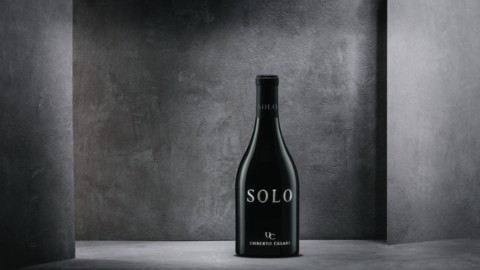A wine that interprets the philosophy of the historical moment, in which sharing and integration are key elements and in spite of the name "is not born in solitude, but from the need to talk to each other and get even closer".
Gianmaria Cesari, owner of the Umberto Cesari, a company founded in 1964 in Castel San Pietro Terme, among the first in Emilia Romagna to believe in the great potential of native vines such as Sangiovese, Trebbiano, Albana di Romagna and Pignoletto, passed from the initial 20 hectares, to the current 355 of which 175 are owned and 180 are rented, thus describes the birth of "Solo" an oenological project shared with his father Umberto produced from Merlese grapes, a new vine fruit of a marriage between two important parents: Sangiovese and Merlot.
“The vines – he underlines – are almost all born from spontaneous crossings, or from a fortuitous exchange of pollen between two subjects, but if man facilitates the arrival of pollen of a precise variety (Merlot) on the ovary of another of interest (Sangiovese) grape seeds are obtained which, when sown, give rise to a new variety. One of these grape seeds gave birth to Merlese”.
A project that required years of study and experimentation, determination and tenacity, carry on with the University of Bologna with great commitment, "but they have allowed us to arrive at this unicum where theory and practice meet perfectly".
And so here is “Solo” wine of an intense, brilliant ruby red color with violet reflections, which is striking for the softness and delicacy well harmonized with the acidity (characteristics found in the two vines that generated it), while the fruity notes of cherry, blackberries and berries go well with the spicy and balsamic tones typical of Merlot. A broad and intense contemporary wine with a great personality, which persists in the aftertaste with a firm but pleasant tannin.
“Solo” – he underlines with the same pride with which a father speaks of his newborn son – is something that didn't exist, something different and unique. An oenological challenge that began years ago, in collaboration with the Faculty of Agriculture of the University of Bologna, (a relationship with the University that has lasted for 40 years) inspired by the new climate context that is emerging. This new variety of vine, more tolerant to environmental stresses compared to its parents (it tolerates drought better than Merlot and resists late rains better than Sangiovese), it has been combined with innovative and sustainable agronomic practices, with the aim of obtaining that resilience which is becoming a necessary condition for today's viticulture.
The Merlese vineyards, cultivated in calcareous soils with a clayey matrix, offer a black berried grape that enjoys a slight earliness inherited from Merlot, combined with a superior resistance capacity, compared to the 'Sangiovese parent'. Merlese matures before Sangiovese, but after Merlot; the leaves resemble those of Merlot, covered with tomenti, the bunch is smaller than the Sangiovese, but larger than the Merlot. The average weight is somewhere between that of the parents, but the interesting aspect is the color that the skins give to the wine. In fact, Merlese boasts a skin rich in polyphenols as well as higher levels of acid and sugar concentration. A grape that brings with it the aromas of Merlot and the strength of Sangiovese, with a gentler and less angular touch.
In 2018 the company was the first in the region to have obtained the "Integrated system of quality of national production" (SQNPI) certification which guarantees the agronomic practices adopted to protect the environment. The lines that make up the Umberto Cesari range are the Red Collection and the White Collection, to which are added a passito and two rosés. Solo will be included in the Red Collection.





